Top 5 Lenses for Your Canon AV-1: A Comprehensive Guide
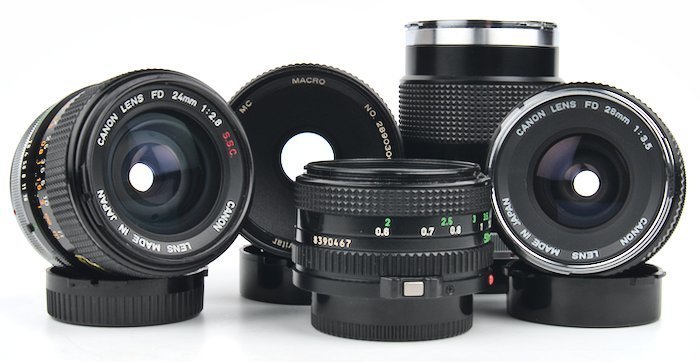
The Canon AV-1 uses Canon FD-mount lenses. There’s a complete lineup of FD lenses, but availability can be an issue.
Here’s the list of best lenses:
Affiliate Advertising Disclosure
Outside the Shot is a participant in the Amazon Services LLC Associates Program, an affiliate advertising program designed to provide a means for sites to earn advertising fees by advertising and linking to Amazon.com.
As an eBay Partner, I may be compensated if you make a purchase. I also participate in affiliate advertising programs with KEH and Adorama. More can be found on the Affiliate Discolsure page.
- Kit Lens - Canon FD 50mm f/1.8 (eBay)
- Wide Angle Lens - Canon FD 28mm f/3.5 (Amazon)
- Portrait Lens - Canon FD 100mm f/2.8 (Amazon)
- Zoom Lens - Vivitar Series 1 70-210mm f/3.5 (eBay)
- Macro Lens - Vivitar 90mm f/2.8 (eBay)
Kit Lens and Standard Primes
Canon FD 50mm f/1.8
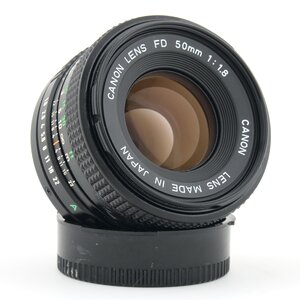
The Canon FD 50mm F/1.8 lens was the “kit Lens” often sold with the AV-1. The 50mm f1.8 is cheap, plentiful, and has very good image quality.
- The “classic” setup as it can be considered the original kit lens.
- Unbeatable value.
- Light and compact.
- Widely available and easy to find in good condition.
- Uses 55mm filter threads.
Check a variety of places to find the best condition and price.
See current price and more information on:
A 50mm lens is a terrific choice for various types of photography. The areas of photography include portraits, street, architecture, travel, casual use, and landscapes. This is the most frequently found focal length that is used with the AV-1.
The lens is small, well balanced, and light. Based on on the version of the lens, it will weigh between 170-305g. The new FD version, which was the last to be designed, is the lightest.
Additionally, Canon built 2 versions with bigger apertures for the FD mount.
Canon FD 50mm f/1.4
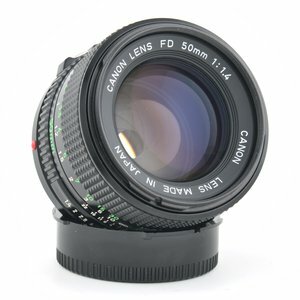
The Canon FD 50mm f/1.4 is 2/3 of a stop faster, but that comes at the cost of additional weight. It is not that much more expensive than the f1.8.
- Excellent image quality.
- Optical multi-coatings.
- Fairly easy to find in good condition.
- Larger and heavier than the f/1.8.
You can find 4 different versions of the 50mm f/1.4. The “new FD” variant is the newest and lightest of the bunch.
See current price and more information on:
A hefty, bulky, and tricky to focus lens. Shot wide open, photographs will not be sharp. If you stop the lens down to f/1.8 or f/1.4 you will not see a notable difference between it and the other lenses.
There are two versions, both are high-priced. Optical performance is not the driver of cost. People want to have the lens due to rarity and collectibility.
Alternative Standard Lenses
If you have a preference for other focal lengths, here are a few other options. Expect to have to spend a greater amount than you normally would for a 50mm lens with a similar aperture.
- Canon FD 35mm f/2 SSC
- Canon FD 35mm f/2.8
- Canon FD 35mm f/3.5
- Canon FD 55mm f/1.2
Wide Angle Lens
Canon FD 28mm f/3.5
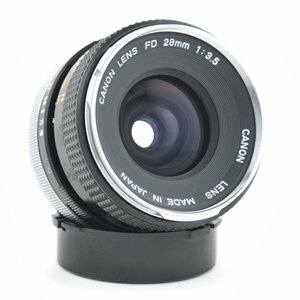
A very popular focal length for street photography is 28mm. However, the most popular use for wide-angle lenses are architectural and landscape photography.
- Great combination with a 50mm lens.
- Optical multi-coatings.
- Inexpensive and widely available.
- Small and light.
See current price and more information on:
My recommended choice is the Canon FD 28mm f/2.8 thanks to the inexpensive price, wide availability, and superb optics.
Alternative Wide Angle Lenses
In terms of cost, the relationship is simple. The larger the field of view, the higher priced the lens will be. Lenses with larger apertures also go for noticeably more.
Weight will differ depending on the characteristics of the lens. You can get lenses from 170g to 500g. Faster apertures will also mean that those lenses will physically be large and cause the camera to be more difficult to handle.
- Canon FD 7.5mm f/5.6 Fisheye
- Canon FD 14mm f/2.8L
- Canon FD 15mm f/2.8
- Canon FD 17mm f/4
- Canon FD 20mm f/2.8
- Canon FD 24mm f/1.4
- Canon FD 24mm f/2
- Canon FD 24mm f/2.8
- Canon FD 28mm f/2
- Canon FD 28mm f/2.8
Portrait & Telephoto Lens
Canon FD 100mm f/2.8
The 85mm lens wasn’t as significant when the AV-1 was initially made. Instead, the 135mm focal length was the go to lens for portraits.
- Excellent portrait lens.
- Less expensive 85mm alternative.
- Great value.
- Inexpensive.
See current price and more information on:
For taking portrait photos with the AV-1, there are a bunch of short telephoto lenses to select among. The 100mm f/2.8 lens is one of the least expensive options around.
An 85mm lens will be the most expensive, with 135mm lenses making up the middle of the price bracket.
As every one of the Canon FD telephoto lenses will be manual focus, they are smaller sized than autofocus versions. Not surprisingly, something like the Canon FD 85mm f/1.2L will certainly be enormous and hefty due to the quantity of glass in the lens.
Anticipate very affordable prices for the Canon FD 100mm f/2.8. Addititionally there is a 100mm f/4 macro version of the lens. It will will cost more and is not the best choice for portraits as the lens should be stopped down.
Alternative Telephoto Lenses
An alternative, the Canon FD 135mm f/2.8 is among the most economical prime lenses you can purchase. You will have to look through a multitude of listings for third-party 135mm lenses that are usually not anywhere near as good as a Canon lens.
There is a range of 85mm lenses to choose from. The priciest is the Canon FD f/1.2L lens. A cheaper pick is the Canon FD 85mm f/1.8 lens, but it is still somewhat less affordable as opposed to the various telephoto lenses in this article.
- Canon FD 85mm f/1.2L
- Canon FD 85mm f/1.8
- Canon FD 100mm f/2
- Canon FD 135mm f/2.5
- Canon FD 200mm f/2.8
- Canon FD 200mm f/4
AV-1 Zoom Lenses
Canon FD 35-105mm f/3.5 & Vivitar Series 1 70-210mm f/3.5
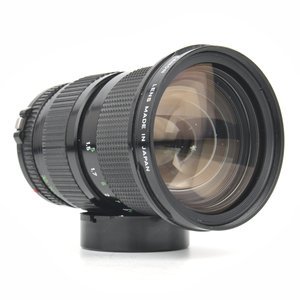
The practicality of pairing a AV-1 along with a zoom lens is appealing. Being able to use a range of focal lengths with no need to swap a lens is advantageous.
Be aware that these are vintage zoom lenses.
- Haze and or Fungus
- Large amount of dust in the lens
- Loose or tight zoom ring
- Loose or tight focus ring
- Oil on the aperture blades
- Decentered lens elements
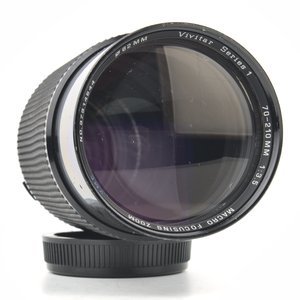
Additionally, you need to keep in mind the drawbacks the lenses have even when in excellent condition.
- Image quality will not be good when shot wide open.
- One or both ends of the focal range may suffer from a large amount of distortion.
- Zoom lenses are larger and generally heavier than primes.
Alternative Zoom Lenses
In terms of pricing, almost all older zooms are going to be cheap.
- Canon FD 70-210mm f/4
- Canon FD 80-200mm f/4L
- Canon FD 28-85mm f/4
Macro Lens
Vivitar 90mm f/2.8 & Vivitar 55mm f/2.8
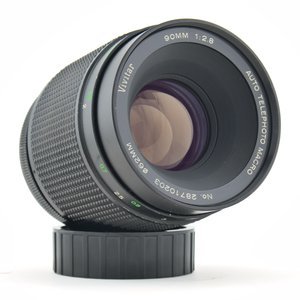
- My favorite vintage macro lens.
- Available in multiple lens mounts.
- Incredible value.
- Sharp corner-to-corner at f/8.
See current price and more information on:
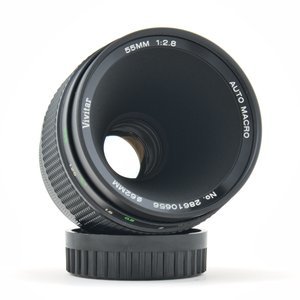
- My second favorite vintage macro lens.
- An excellent choice for close-up photography.
- It does not need an extension tube to reach 1:1 magnification.
See current price and more information on:
The two recommended macro lenses were manufactured by Komine in Japan. The lens was also released with many different brand names. Spiratone, Rokunar, Elicar, Quantaray, and Panagor are brands you can see on a copy of the lens.
There is a Vivitar 90mm f/2.8 Macro Lens Review and a Vivitar 55mm f/2.8 Macro Lens Review.
For capturing images at lifesize magnification (1:1), the 90mm lens will probably be the superior pick due to the fact that it has a larger working distance.
The 55mm lens is good for table-top and close-up photography.
Alternative Macro Lenses
- Canon FD 50mm f/3.5
- Canon FD 100mm f/4
- Canon FD 200mm f/4
Used FD Camera Lens Prices
Lens prices are continuously changing. During the past several years, the desireability of film photography has been increasing. Consequently, price ranges have gradually climbed.
To get the lowest price, obtaina lot of online stores. Promptly pay for a really good price the moment you see one due to the fact that it can be a very long time until another appears.
What Lens Mount Does the Canon AE-1 Use?
The AV-1 makes use of the Canon FD lens mount. Canon used the FD mount for film cameras built starting in 1971 and ending in 1992.
The FD lens mount replaced the Canon FL lens mount, which was utilized from 1964 - 1971. FL mount lenses can be used with the AV-1, but you should be prepared to use stopped down metering.
Standard Lens Cap Size
The standard lens cap and filter ring thread diameter for Canon FD lenses is 55mm.
Making use of a standardized filter thread size is nice since you just need to pick up and carry a single set of filters.
A handful of telephoto and zooms have larger filter ring thread diameters since they have substantial front lens elements.
FD vs FL Lens Mount
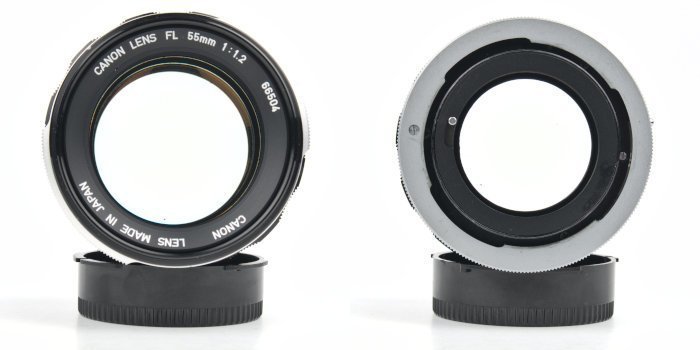
The Canon FL mount preceded the FD mount. You can use FL mount lenses on the FD mount, and FD lenses can be used on the FL lens mount.
What Canon FL mount lenses are unable to do auto stop-down metering. As a result the lens stopped down with the depth-of-preview switch to ensure that the AV-1’s light meter to show an accurate reading.
FD vs new FD Lenses
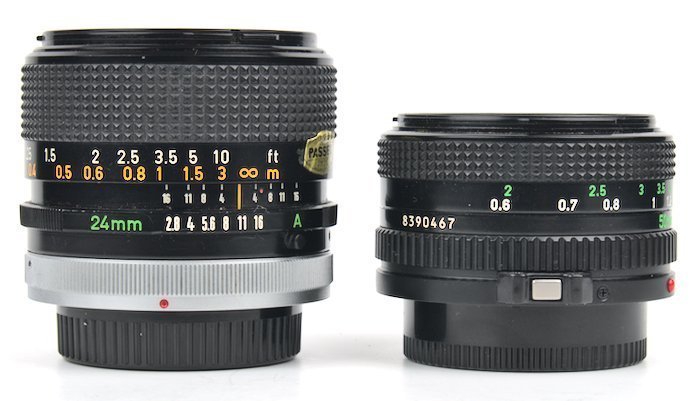
The whole body of the new FD lens rotates to lock onto the camera. Compared to original FD lenses which have a breech-lock ring at the rear of the lens that must be tightened to be able to mount a lens.
New FD and FD lenses are interchangeable with each other. There will be no compatibility issues.
In some cases you will find new FD lenses referred to as FDn lenses.
The modification in the design of the breech-lock ring was because of complaints. A small group of users suffered from lenses getting stuck on a FD camera.
If you have not mounted an FD mount lens to a camera, don’t get worried. Simply take it slow and do not force anything.
Telling FD and FDn Lenses Apart
It is easy to tell FD and new FD lenses apart. New FD lenses will have a silver button on the outside of the lens, where the lens mounts to the camera.
Older FD lenses have a metal ring that needs to be rotated after the lens is attached to lock it into place.
More Canon AE-1 Camera Resources
That finishes the best AV-1 lenses. Immediately after more information on the camera is put onto this website, it will be linked to here.